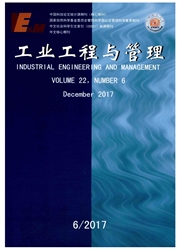

 中文摘要:
中文摘要:
为了克服第三方物流在处理逆向物流时难以达到规模经济的问题,将第四方物流服务模型引入零散、不确定的逆向物流服务中,提出第四方物流模式下物流任务与物流资源的优化匹配问题,并对此进行了初步的探索。提出了两级物流资源优化配置策略,即首先将具有相似属性的零散的逆向物流任务进行聚类整合,再将整合后的物流任务与第三方物流资源进行优化匹配。以总成本最小和完成时间最短为目标,建立了逆向物流资源优化配置模型,设计了求解该模型的遗传算法,最后用实例验证了模型和算法的有效性,为第四方逆向物流服务模式的实用化奠定了基础。
 英文摘要:
英文摘要:
It is difficult for a third party logistics (3PL) service provider to reach scale economy for reverse logistics services. In order to overcome this shortcoming, fourth party logistics (4PL) is adapted to deal with the scattered and uncertain reverse logistics tasks. A research question of optimal resources configuration for forth party reverse logistics is proposed and some original researches are conducted. A two-step strategy of optimal resources configuration is submitted. The first step is to cluster similar reverse logistics tasks. The second step is to match the consolidated reverse logistics tasks with resources of 3PL service providers. Aiming at minimizing operation cost and completion time of total reverse logistics tasks, a model of reverse logistics resources configuration is proposed and a genetic algorithm is designed to solve the model. The validity of proposed model and algorithm are verified by a corresponding case study. This research shorts the gap between concept of 4PL and its application.
 同期刊论文项目
同期刊论文项目
 同项目期刊论文
同项目期刊论文
 Integration of rough set and neural network ensemble to predict the configuration performance of a m
Integration of rough set and neural network ensemble to predict the configuration performance of a m 期刊信息
期刊信息
